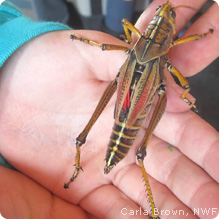
Learn how to catch, keep, and observe a grasshopper.
What You Need
- Large jar or aquarium with a screen lid
- Butterfly or insect net
- Grass or lettuce
- Journal/notebook
What You Do
- Catch a Grasshopper
- You might try to cup one hand over it and then scoop it up with the other hand. But be careful: The legs might be sharp and prickly. And you might get “juiced.” (That’s just a little icky bug vomit to try to make you go away. It won’t hurt you.)
- Another way is to coax one up a plant stem and then tap it into a container. Or use a butterfly or insect net to scoop one up. Hold the grasshopper with your fingers on the sides of its body behind its head. Don’t worry—it won’t bite.

- Keep a Grasshopper
- House your hopper in a large jar or aquarium with a screen lid, away from direct sunlight. A lamp or light bulb next to the container can supply warmth.
- Add fresh food, such as grass or lettuce, each day. Don’t worry about water—it’s in the food. Include a bit of wheat germ.
- Study Your Grasshopper
- Check out your hopper’s color, body parts, and behavior. Use a magnifier for a better look.
- Can you find five eyes? (Hint: two are big.) Breathing holes along the sides of the abdomen? Jaws?
- Does it have wings? Are the antennae short or long? How does it use its front legs? Rear legs?
- Keep a journal of its activities and your discoveries. Then, after a few days, take your hopper back to where you found it and let it go.
Here are some of the species (kinds) of grasshoppers you might find. Click each name for a flashcard of fast facts!
- Differential Grasshopper
- American Bird Grasshopper
- Devastating Grasshopper
- Migratory Grasshopper
- Pallid-winged Grasshopper
- Southeastern Lubber Grasshopper
- Red-legged Locust
- Two-striped Grasshopper
- Speckled Rangeland Grasshopper

